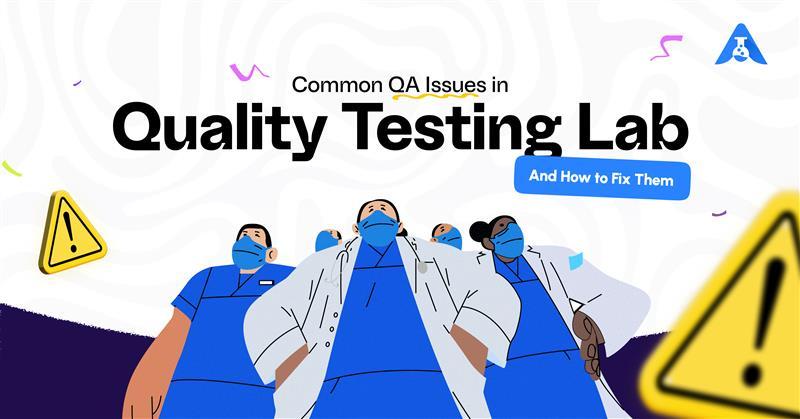Quality testing laboratories are the backbone of decision-making across industries, from pharmaceutical safety and environmental protection to food quality and materials testing.
Their role? To deliver accurate, reproducible, and compliant results that can be trusted by clients, regulators, and stakeholders.
Yet even the most advanced laboratories can face quality-related setbacks that compromise data integrity, credibility, and compliance.
In this blog, let’s examine a few critical quality assurance challenges faced by modern quality testing laboratories with real-life scenarios and practical strategies to overcome them.
Issue #1: Errors in Test Results
A pharmaceutical testing lab conducts dissolution testing for a generic drug batch. The results show inconsistent release rates, far from the pharmacopeial specifications. Upon investigation, it was discovered that minor deviations in SOPs and inconsistencies in media preparation caused errors.
How To Fix This
Establish strict adherence to validated test methods. Standardize sample preparation steps, use control samples, and participate in inter-laboratory proficiency testing. Regular method validation and review of historical data trends can help detect drifts early and ensure sustained result accuracy.
Issue #2: Improper Sample Handling
In a water testing laboratory, two samples from different locations are mistakenly swapped due to manual labeling during a busy shift. This leads to an erroneous report claiming industrial pollutants in a pristine area, prompting unnecessary public concern.
How To Fix This
Enforce barcoded sample tracking systems and digital logbooks. Segregate high-risk and low-risk samples, implement cleanroom protocols where needed, and provide clear SOPs for sample intake, handling, and storage to avoid confusion and cross-contact.
Issue #3: The Invisible Contaminants
A pathogen-testing laboratory starts seeing unexplained colony growth in negative control plates. After investigation, poor HVAC maintenance and inconsistent temperature control in the incubation area were found to be the root cause.
How To Fix This
Implement continuous monitoring of environmental conditions such as temperature, humidity, and air quality. Schedule periodic cleanroom certification, filter replacements, and microbial air sampling. Train staff in good laboratory practices (GLP) to minimize contamination risks.
Issue #4: Defective Instruments and Calibration Blunders
A materials testing lab fails to detect a crack in a high-pressure vessel sample. The ultrasonic flaw detector used was overdue for calibration, resulting in undetected anomalies and a serious client complaint.
How To Fix This
Implement a preventive maintenance program that includes calibration schedules based on manufacturer recommendations. Use service logs, calibration certificates, and periodic equipment verification to ensure instruments perform within specified tolerances.
Issue #5: Skill Gaps in the Lab
A newly hired technician at a pathology lab fails to follow the standard antigen retrieval protocol during immunohistochemistry, leading to false-negative results in cancer biopsy samples.
How To Fix This
Create structured onboarding and refresher training programs. Assess technical competency periodically through proficiency testing and peer reviews. Encourage knowledge-sharing sessions, SOP walkthroughs, and documentation-based training to foster confidence and consistency in the lab.
Issue #6: The Communication Gap
An environmental testing lab handling water samples during a contamination crisis fails to update the municipal authority on delays, resulting in loss of trust and non-renewal of the service contract.
How To Fix This
Define turnaround expectations clearly for different test types. Maintain a client communication log and provide real-time updates on sample receipt, testing status, and report availability. Set up an escalation process for urgent requests and delay alerts.
Issue #7: Data Integrity Issues
A clinical testing lab is flagged during inspection when regulators discover that temperature logs for critical reagents were recorded manually and later altered to appear within the acceptable range.
How To Fix This
Transition to electronic data capture systems that offer audit trails, timestamped entries, and user access controls. Train all staff on ALCOA+ principles (Attributable, Legible, Contemporaneous, Original, Accurate) and enforce a zero-tolerance policy for data tampering.
Issue #8: Falling Behind on Compliance
A contract lab loses its accreditation status when an inspection reveals expired SOPs, missing competency assessments, and improper handling of customer complaints.
How To Fix This
Stay up to date with evolving regulatory requirements (e.g., FDA, EPA, NABL, ISO). Review SOPs regularly, train staff on compliance expectations, and document all client interactions, complaints, and resolutions. Prepare for routine and unannounced audits with readiness checklists and mock assessments.
Quality Is Not a One-Time Act
Testing laboratories that prioritize quality not only deliver better results, but they also earn long-term trust, achieve higher customer retention, and reduce the risk of costly non-compliance.
By proactively addressing these common quality issues, laboratories can elevate their standards, safeguard their data, and establish a reputation for excellence.
Step into a smarter, more resilient future of laboratory quality management with intuitive lab informatics solutions from Agaram Technologies. Check out the perfect LIMS, ELN and SDMS to elevate your lab’s performance here. If you would like to get familiar with these intuitive solutions, we’re always ready to give you a comprehensive demo!





